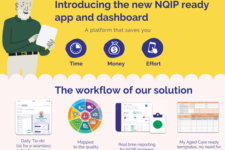With a focus on quality outcomes for consumers, the Aged Care Quality & Safety Standards hopes to encourage continuous improvement, innovation, and excellence in aged care services.
The inclusion of consumer outcome statements represents a shift in how aged care quality is measured, and presents providers with the challenge of gathering tangible evidence that they are meeting and exceeding customer expectations.
Similar to most working environments, one of the most reflective measures of aged care performance is real-time feedback.
On-going engagement with customers, families, employees, and referrers, gives aged care services a valuable insight to uncover potential issues and implement ideas for future improvements that result in better outcomes for those in their care.
Although the vast majority of organisations strive to provide the best level of care every day, there will be times when things go wrong, and this can result in feedback that many are quick to deem negative.
Customer complaints can be daunting.
However, when handled effectively, feedback can become an aged care services biggest asset for both process improvement and relationship building with their residents and staff alike.
In fact, research shows that when complaints are handled appropriately, customers report higher levels of satisfaction and brand advocacy.
Organisations that are focused on continuous improvement view each complaint as a learning opportunity and a chance to look at why something happened and how it can be improved.
These organisations actively encourage consumers to raise their concerns, and they provide multiple avenues to do so.
Only a small number of people who are dissatisfied with any particular service will raise a complaint without being asked, but to truly drive continuous improvement in aged care, we need to shift from a reactive mindset and begin to take a proactive approach.
The current approach towards feedback by many providers is reactive, meaning that they wait for consumers to provide their feedback (often in the form of a complaint) and deal with any problems as they arise.
There are also others who may operate a system that directly solicits feedback, such a customer satisfaction survey, but this is often done annually.
Relying on data that is only reflective of one period can be extremely misleading, and provides little insight into the day-to-day experiences of customers.
The most useful feedback systems are proactive, allowing customers to share their experience in real-time.
The best systems, those that deliver more in-depth insights into how and where an organisation can improve, listen to both customers and employees, providing opportunities for regular feedback and every touch-point on the customer journey.
“…its frontline agents enable the function to hear the “voice of the customer” on a daily basis, monitor trends and overall sentiment, and identify pain points, improvement levers, and success factors.”
McKinsey, March 2018, The role of customer care in customer experience transformation
While McKinsey is referring to customer service teams, the same sentiment can easily be applied to nurses and care professionals. Encouraging staff to provide regular feedback is a crucial element of continuous improvement.
They can provide valuable insights into what is working, and what is not.
And when you consider the impact of aged care staff have on consumer perceptions of quality, not regularly checking-in presents a real risk.
COTA’s 2018 research, Measuring Quality and Consumer Choice in Aged Care,’ found that when consumers were asked what the most critical quality of life indicators were, staff friendliness came out second (behind being treated with dignity and respect.)
In a time where aged care managers are increasingly asked to deliver more with less, the prospect of gathering on-going feedback, on top of other compliance reporting requirements, can seem intimidating, if not impossible.
However, technology can provide an effective solution.
Customer experience software, such as CarePage, provides an efficient and cost-effective method to monitor and evidence feedback.
By embracing technology, providers can harness real-time customer experience data and benchmarking metrics to see feedback trends and address areas of concern quickly.







